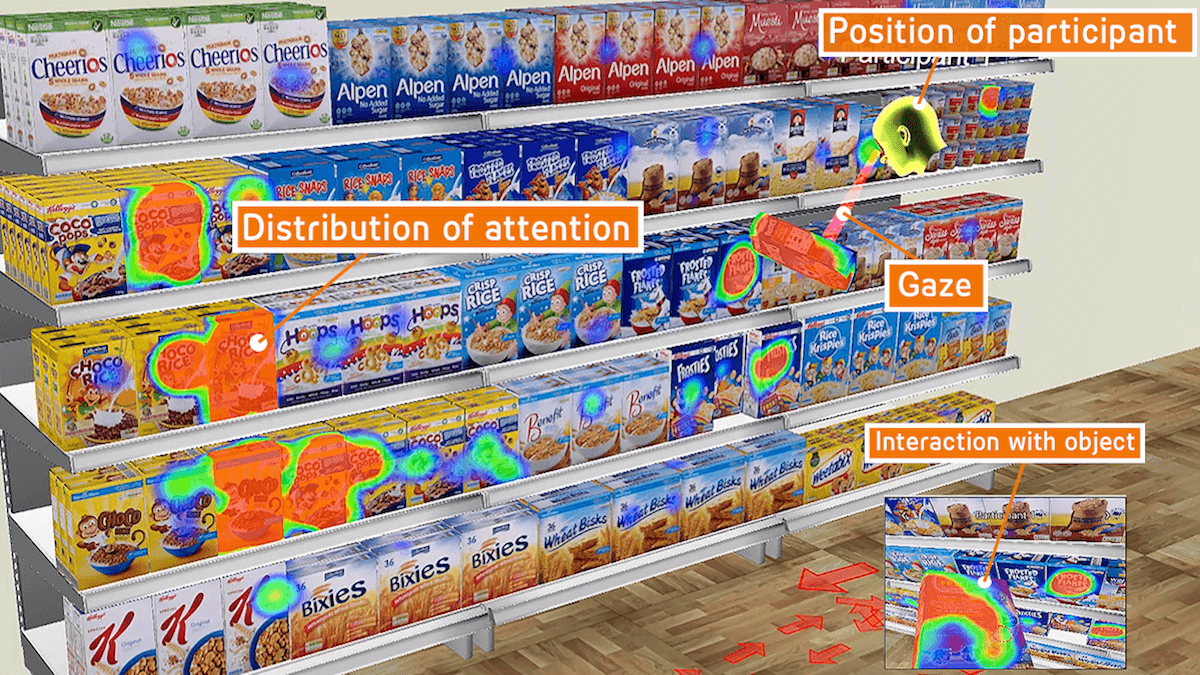Tobii Pro releases analytics for its eye-tracking + VR
A year ago, the eye-tracking firm released an integration with the HTC Vive VR headset, but data analytics required a programmer.

Last summer, Tobii Pro announced an integration between its eye-tracking tech and the HTC Vive virtual reality (VR) headset. This allowed eye-tracking precision for marketers looking to understand exactly what consumers were viewing as they “walked” through virtual environments like simulated grocery stores.
But, Director of Research Tim Holmes told me, setting up the heat maps or tracking the user’s gaze and virtual movements required a programmer familiar with the Unity platform, which is used with the Vive.
Now, the Stockholm-based company has taken the next step by releasing VR Analytics. It allows marketers to set up heat maps, opacity maps and journey maps by clicking the respective buttons on the Tobii dashboard and see data that depicts the results. A heat map indicates the areas receiving the most visual attention, an opacity map darkens some areas of the scene to focus attention on others, and journey maps in this case track the head movements and position of the user.
https://www.youtube.com/watch?v=hTKy0dps8X0
The use cases are similar to when the hardware integration was first announced, but now they do not require a programmer to start seeing results. Typical use cases, Tobii says, include a retailer who might want to optimize the layout of a physical store or a brand that wants to determine which of several package designs most attract the visual attention of users. Obviously, the variations can be unlimited when they are virtual. Here’s a sample analytics screen:
The setup can also be used for training, such as tracking surgeons’ attention while using specific surgical techniques or testing pilots’ visual awareness during a simulated flight. The environment can employ photographic realism mapped onto 3D shapes, as well as 3D that has a more graphical and constructed look.
Holmes pointed to another use of the technology to explore a new environment: a Mondrian painting.
He and a colleague, with support from Tobii, generated a VR environment which visualized a room designed by the painter Mondrian but never realized. When users walked through the resulting visual space, Holmes said, the analytics could track their visual attention while they were essentially inside a painting.
I asked Holmes whether Tobii accounted for the differences in user reactions and movements inside a physical environment compared to being inside an artificial one, even one utilizing photographic realism.
He said this use of VR with eye-tracking “is still new enough that there are not enough studies” yet about those differences.
Compared to other VR and eye-tracking providers who might collaborate, he said, Tobii Pro’s is “the most vigorous research-based eye tracking platform on the market” that utilizes VR.
Contributing authors are invited to create content for MarTech and are chosen for their expertise and contribution to the martech community. Our contributors work under the oversight of the editorial staff and contributions are checked for quality and relevance to our readers. MarTech is owned by Semrush. Contributor was not asked to make any direct or indirect mentions of Semrush. The opinions they express are their own.
Related stories
New on MarTech